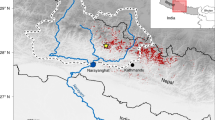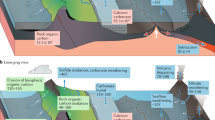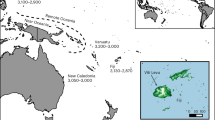Abstract
Rapid ground accelerations during earthquakes can trigger landslides that disturb mountain forests and harvest carbon from soils and vegetation. Although infrequent over human timescales, these co-seismic landslides can set the rates of geomorphic processes over centuries to millennia. However, the long-term impacts of earthquakes and landslides on carbon export from the biosphere remain poorly constrained. Here, we examine the sedimentary fill of Lake Paringa, New Zealand, which is fed by a river draining steep mountains proximal to the Alpine Fault. Carbon isotopes reveal enhanced accumulation rates of biospheric carbon after four large earthquakes over the past ~1,100 years, probably reflecting delivery of soil-derived carbon eroded by deep-seated landslides. Cumulatively these pulses of earthquake-mobilized carbon represent 23 ± 5% of the record length, but account for 43 ± 5% of the biospheric carbon in the core. Landslide simulations suggest that 14 ± 5 million tonnes of carbon (MtC) could be eroded in each earthquake. Our findings support a link between active tectonics and the surface carbon cycle and suggest that large earthquakes can significantly contribute to carbon export from mountain forests over millennia.
This is a preview of subscription content, access via your institution
Access options
Access Nature and 54 other Nature Portfolio journals
Get Nature+, our best-value online-access subscription
$29.99 / 30 days
cancel any time
Subscribe to this journal
Receive 12 print issues and online access
$259.00 per year
only $21.58 per issue
Buy this article
- Purchase on Springer Link
- Instant access to full article PDF
Prices may be subject to local taxes which are calculated during checkout



Similar content being viewed by others
References
Garwood, N. C., Janos, D. P. & Brokaw, N. Earthquake-caused landslides: a major disturbance to tropical forests. Science 205, 997–999 (1979).
Allen, R. B., Bellingham, P. J. & Wiser, S. K. Immediate damage by an earthquake to a temperate montane forest. Ecology 80, 708–714 (1999).
Veblen, T. T. & Ashton, D. H. Catastrophic influences on the vegetation of the Valdivian Andes, Chile. Vegetatio 36, 149–167 (1978).
Hilton, R. G., Meunier, P., Hovius, N., Bellingham, P. J. & Galy, A. Landslide impact on organic carbon cycling in a temperate montane forest. Earth Surf. Proc. Land. 36, 1670–1679 (2011).
Chen, H., Wu, N., Yuan, X., Gao, Y. & Zhu, D. Aftermath of the Wenchuan earthquake. Front. Ecol. Environ. 7, 72 (2009).
Hovius, N., & Stark, C. P., & Allen, P. A. Sediment flux from a mountain belt derived by landslide mapping. Geology 25, 231–234 1997).
Rathburn, S. L. et al. The fate of sediment, wood, and organic carbon eroded during an extreme flood, Colorado Front Range, USA. Geology 45, 499–502 (2017).
Kao, S. J. et al. Preservation of terrestrial organic carbon in marine sediments offshore Taiwan: mountain building and atmospheric carbon dioxide sequestration. Earth Surf. Dyn. 2, 127–139 (2014).
Leithold, E. L. et al. Signals of watershed change preserved in organic carbon buried on the continental margin seaward of the Waipaoa River, New Zealand. Mar. Geol. 346, 355–365 (2013).
Galy, V., Peucker-Ehrenbrink, B. & Eglinton, T. Global carbon export from the terrestrial biosphere controlled by erosion. Nature 521, 204–207 (2015).
Hilton, R. G. Climate regulates the erosional carbon export from the terrestrial biosphere. Geomorphology 277, 118–132 (2017).
Blair, N. E. & Aller, R. C. The fate of terrestrial organic carbon in the marine environment. Annu. Rev. Mar. Sci. 4, 401–423 (2012).
Hovius, N. et al. Prolonged seismically induced erosion and the mass balance of a large earthquake. Earth Planet. Sci. Lett. 304, 347–355 (2011).
Wang, J. et al. Controls on fluvial evacuation of sediment from earthquake-triggered landslides. Geology 43, 115–118 (2015).
Dadson, S. J. et al. Earthquake-triggered increase in sediment delivery from an active mountain belt. Geology 32, 733–736 (2004).
Keefer, D. K. The importance of earthquake-induced landslides to long-term slope erosion and slope-failure hazards in seismically active regions. Geomorphology 10, 265–284 (1994).
Li, G. et al. Seismic mountain building: landslides associated with the 2008 Wenchuan earthquake in the context of a generalized model for earthquake volume balance. Geochem. Geophy. Geosy. 15, 833–844 (2014).
Marc, O., Hovius, N., Meunier, P., Gorum, T., & Uchida, T. A seismologically consistent expression for the total area and volume of earthquake-triggered landsliding. J. Geophys. Res. Earth Surf. https://doi.org/10.1002/2015JF003732 (2016).
Wang, J. et al. Earthquake-triggered increase in biospheric carbon export from a mountain belt. Geology 44, 471–474 (2016).
Howarth, J. D., Fitzsimons, S. J., Norris, R. J. & Jacobsen, G. E. Lake sediments record cycles of sediment flux driven by large earthquakes on the Alpine Fault, New Zealand. Geology 40, 1091–1094 (2012).
Hovius, N., Stark, C. P. & Allen, P. A. Sediment flux from a mountain belt derived by landslide mapping. Geology 25, 231–234 (1997).
Korup, O., McSaveney, M. J. & Davies, T. R. H. Sediment generation and delivery from large historic landslides in the Southern Alps, New Zealand. Geomorphology 61, 189–207 (2004).
Norris, R. J. & Cooper, A. F. Late Quaternary slip rates and slip partitioning on the Alpine Fault, New Zealand. J. Struct. Geol. 23, 507–520 (2001).
Henderson, R. D. & Thompson, S. M. Extreme rainfalls in the Southern Alps of New Zealand. J. Hydrol. (New Zealand) 38, 309–330 (1999).
Bellingham, P. J. & Richardson, S. J. Tree seedling growth and survival over 6 years across different microsites in a temperate rain forest. Can. J. Forest Res. 36, 910–918 (2006).
Sutherland, R., et al. in A Continental Plate Boundary: Tectonics at South Island, New Zealand (eds. Okaya, D. et al.) 235–251 (American Geophysical Union Geophysical Monograph 175, 2007).
Wells, A., Yetton, M. D., Duncan, R. P. & Stewart, G. H. Prehistoric dates of the most recent Alpine fault earthquakes, New Zealand. Geology 27, 995–998 (1999).
Berryman, K. R. et al. Late Holocene rupture history of the Alpine Fault in South Westland, New Zealand. Bull. Seismol. Soc. Am. 102, 620–638 (2012).
Howarth, J. D., Fitzsimons, S. J., Norris, R. J. & Jacobsen, G. E. Lake sediments record high intensity shaking that provides insight into the location and rupture length of large earthquakes on the Alpine Fault, New Zealand. Earth Planet. Sci. Lett. 403, 340–351 (2014).
Howarth, J. D., Fitzsimons, S. J., Norris, R. J., Langridge, R. & Vandergoes, M. J. A 2000 yr rupture history for the Alpine Fault derived from Lake Ellery, South Island, New Zealand. Geol. Soc. Am. Bull. 128, 627–643 (2015).
Cochran, U. A. et al. A plate boundary earthquake record from a wetland adjacent to the Alpine fault in New Zealand refines hazard estimates. Earth Planet. Sci. Lett. 464, 175–188 (2017).
Hilton, R. G., Galy, A. & Hovius, N. Riverine particulate organic carbon from an active mountain belt: Importance of landslides. Global Biogeochem. Cycles 22, GB1017 (2008).
Nibourel, L., Herman, F., Cox, S. C., Beyssac, O. & Lavé, J. Provenance analysis using Raman spectroscopy of carbonaceous material: a case study in the Southern Alps of New Zealand. J. Geophys. Res. Earth Surf. 120, 2056–2079 (2015).
Horan, K. et al. Mountain glaciation drives rapid oxidation of rock-bound organic carbon. Sci. Adv. 3, e1701107 (2017).
Ehleringer, J. R., Buchmann, N. & Flanagan, L. B. Carbon isotope ratios in belowground carbon cycle processes. Ecol. Appl. 10, 412–422 (2000).
Hogg, A. G. et al. SHCal13 Southern Hemisphere calibration, 0–50,000 years cal bp. Radiocarbon 55, 1889–1903 (2013).
Soulet, G., Skinner, L. C., Beaupré, S. R. & Galy, V. A note on reporting of reservoir 14C disequilibria and age offsets. Radiocarbon 58, 205–211 (2016).
Larsen, I. J., Montgomery, D. R. & Korup, O. Landslide erosion caused by hillslope material. Nat. Geosci. 3, 247–251 (2010).
West, A. J. et al. Dilution of 10Be in detrital quartz by earthquake-induced landslides: Implications for determining denudation rates and potential to provide insights into landslide sediment dynamics. Earth Planet. Sci. Lett. 396, 143–153 (2014).
Restrepo, C. et al. Landsliding and its multiscale influence on mountainscapes. Bioscience 59, 685–698 (2009).
Coomes, D. A., Holdaway, R. J., Kobe, R. K., Lines, E. R. & Allen, R. B. A general integrative framework for modelling woody biomass production and carbon sequestration rates in forests. J. Ecol. 100, 42–64 (2012).
Meunier, P., Hovius, N. & Haines, A. J. Regional patterns of earthquake-triggered landslides and their relation to ground motion. Geophys. Res. Lett. 34, L20408 (2007).
Roback, K. et al. The size, distribution, and mobility of landslides caused by the 2015 M w7.8 Gorkha earthquake, Nepal. Geomorphology 301, 121–138 (2017).
New Zealand’s Greenhouse Gas Inventory 1990–2016 (New Zealand Government, 2018).
Larsen, I. J., Montgomery, D. R. & Greenberg, H. M. The contribution of mountains to global denudation. Geology 42, 527–530 (2014).
Shields, G. A. & Mills, B. J. W. Tectonic controls on the long-term carbon isotope mass balance. Proc. Natl Acad. Sci. USA 114, 4318–4323 (2017).
Kreemer, C., Holt, W. E. & Haines, A. J. An integrated global model of present-day plate motions and plate boundary deformation. Geophys. J. Int. 154, 8–34 (2003).
Reif, A. & Allen, R. B. Plant communities of the steepland conifer–broadleaved hardwood forests of central Westland, South Island, New Zealand. Phytocoenologia 16, 145–224 (1988).
Carey, A. E. et al. Organic carbon yields from small, mountainous rivers, New Zealand. Geophys. Res. Lett. 32, L15404 (2005).
Tait, A., Henderson, R., Turner, R. & Zheng, X. Thin plate smoothing spline interpolation of daily rainfall for New Zealand using a climatological rainfall surface. Int. J. Climatol. 26, 2097–2115 (2006).
Cox, S. C. & Barrell, D. J. A. Geology of the Aoraki Area. Institute of Geological and Nuclear Science 1:250,000 Geological Map 15 (GNS Science, Lower Hutt, 2007).
Galy, V., Bouchez, J. & France-Lanord, C. Determination of total organic carbon content and δ 13C in carbonate-rich detrital sediments. Geostand. Geoanal. Res. 31, 199–207 (2007).
Hemingway, J. D. et al. Multiple plant-wax compounds record differential sources and ecosystem structure in large river catchments. Geochim. Cosmochim. Acta. 184, 20–40 (2016).
Bachem, P. E., Risebrobakken, B., De Schepper, S. & McClymont, E. L. Highly variable Pliocene sea surface conditions in the Norwegian Sea. Clim. Past. 13, 1153–1168 (2017).
Turnbull, J. C. et al. Sixty years of radiocarbon dioxide measurements at Wellington, New Zealand 1954–2014. Atmos. Chem. Phys. Discuss. https://doi.org/10.5194/acp-2016-1110 (2016).
Schwanghart, W. & Scherler, D. TopoToolbox 2—MATLAB-based software for topographic analysis and modeling in Earth surface sciences. Earth Surf. Dynam. 2, 1–7 (2014).
Li, G. et al. Connectivity of earthquake-triggered landslides with the fluvial network: implications for landslide sediment transport after the 2008 Wenchuan earthquake. J. Geophys. Res. Earth Surf. 121, 703–724 (2016).
Acknowledgements
N.V.F. completed the research as part of the MSci programme in Geography at Durham University. We thank H. Bloor and A. Moody for field support and E. Maddison, K. Melvin, A. George, M. West and A. Hayton for laboratory support. Samples were collected under Department of Conservation research licence (39411-GEO). Funding was provided by a Durham University Seedcorn Grant, a Natural Environment Research Council Standard Grant to R.G.H., A.L.D., E.L.M. and J.D.H. (NE/P013538/1), a Rutherford Foundation Postdoctoral Fellowship to J.D.H. (RFTGNS1201-PD) and COFUND Junior Research Fellowship at Durham University to J.W.
Author information
Authors and Affiliations
Contributions
R.G.H., J.D.H. and A.L.D. conceived and designed the project. J.D.H. and S.J.F. collected the core, and N.V.F. undertook the sampling and geochemical analysis under the supervision of R.G.H., J.D.H. and D.R.G. J.W. undertook the biomarker analysis and interpretation under direction from E.L.M. and R.G.H. J.D. ran the radiocarbon analyses. N.V.F. analysed and interpreted the bulk data under the supervision of R.G.H., A.L.D. and J.D.H. T.C. computed the Alpine Fault landslide scenarios with R.G.H. and J.D.H. R.G.H., J.D.H and N.V.F. wrote the paper with input from all authors.
Corresponding author
Ethics declarations
Competing interests
The authors declare no competing interests.
Additional information
Publisher’s note: Springer Nature remains neutral with regard to jurisdictional claims in published maps and institutional affiliations.
Supplementary information
Supplementary Information
Supplementary text and figures
Supplementary Data
Supplementary dataset
Rights and permissions
About this article
Cite this article
Frith, N.V., Hilton, R.G., Howarth, J.D. et al. Carbon export from mountain forests enhanced by earthquake-triggered landslides over millennia. Nature Geosci 11, 772–776 (2018). https://doi.org/10.1038/s41561-018-0216-3
Received:
Accepted:
Published:
Issue Date:
DOI: https://doi.org/10.1038/s41561-018-0216-3
This article is cited by
-
Shifts of forest resilience after seismic disturbances in tectonically active regions
Nature Geoscience (2024)
-
Inversions of landslide strength as a proxy for subsurface weathering
Nature Communications (2022)
-
Topographic stress control on bedrock landslide size
Nature Geoscience (2021)
-
Stressed rocks cause big landslides
Nature Geoscience (2021)
-
An unshakable carbon budget for the Himalaya
Nature Geoscience (2021)



